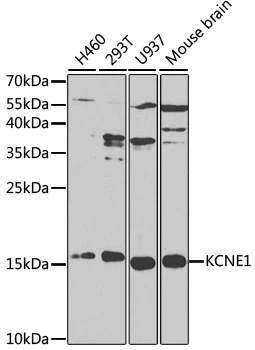
WB analysis of various sample lysates using GTX54296 KCNE1 antibody. Dilution : 1:1000 Loading : 25microg per lane
KCNE1 antibody
GTX54296
Overview
- SupplierGeneTex
- Product NameKCNE1 antibody
- Delivery Days Customer7
- Application Supplier NoteWB: 1:500 - 1:2000. *Optimal dilutions/concentrations should be determined by the researcher.Not tested in other applications.
- ApplicationsWestern Blot
- CertificationResearch Use Only
- ClonalityPolyclonal
- ConjugateUnconjugated
- Gene ID3753
- Target nameKCNE1
- Target descriptionpotassium voltage-gated channel subfamily E regulatory subunit 1
- Target synonymscardiac delayed rectifier potassium channel protein; delayed rectifier potassium channel subunit IsK; IKs producing slow voltage-gated potassium channel subunit beta Mink; ISK; JLNS; JLNS2; Long QT syndrome 5; LQT2/5; LQT5; minimal potassium channel; MinK; potassium channel, voltage gated subfamily E regulatory beta subunit 1; potassium voltage-gated channel subfamily E member 1; potassium voltage-gated channel, Isk-related family, member 1; potassium voltage-gated channel, Isk-related subfamily, member 1; voltage gated potassiun channel accessory subunit
- HostRabbit
- IsotypeIgG
- Protein IDP15382
- Protein NamePotassium voltage-gated channel subfamily E member 1
- Scientific DescriptionThe product of this gene belongs to the potassium channel KCNE family. Potassium ion channels are essential to many cellular functions and show a high degree of diversity, varying in their electrophysiologic and pharmacologic properties. This gene encodes a transmembrane protein known to associate with the product of the KVLQT1 gene to form the delayed rectifier potassium channel. Mutation in this gene are associated with both Jervell and Lange-Nielsen and Romano-Ward forms of long-QT syndrome. Alternatively spliced transcript variants encoding the same protein have been identified. [provided by RefSeq, Jul 2008]
- ReactivityHuman, Mouse
- Storage Instruction-20°C or -80°C,2°C to 8°C
- UNSPSC12352203
